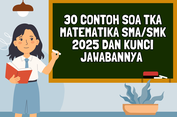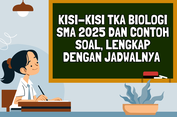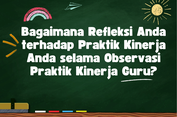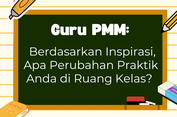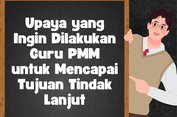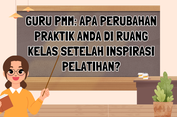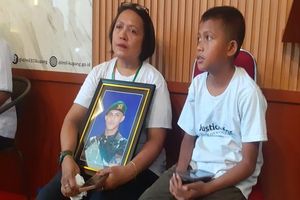45 Kunci Jawaban Simulasi TKA Bahasa Inggris Kelas 12
KOMPAS.com - Tes Kemampuan Akademik (TKA) bagi siswa kelas 12 SMA dan SMK sederajat akan segera digelar pada awal November 2025.
Ujian ini menjadi bagian dari asesmen nasional yang berfungsi mengukur capaian akademik siswa pada mata pelajaran utama, termasuk Bahasa Inggris.
Berdasarkan jadwal dari Kementerian Pendidikan, Kebudayaan, Riset, dan Teknologi, TKA akan berlangsung dalam tiga gelombang, yakni pada 3–4 November 2025, 5–6 November 2025, serta 8–9 November 2025 untuk gelombang khusus.
Menjelang pelaksanaannya, siswa diimbau untuk mulai berlatih mengerjakan contoh soal TKA Bahasa Inggris secara mandiri.
Latihan ini membantu memahami tipe pertanyaan yang berfokus pada keterampilan membaca teks dalam konteks akademik, vokasional, maupun sehari-hari, sebagaimana dijelaskan oleh Pusat Asesmen Pendidikan (Pusmendik).
Sebagai referensi belajar, berikut rangkuman 45 contoh soal TKA Bahasa Inggris SMA kelas 12 lengkap dengan kunci jawaban yang dapat digunakan untuk latihan di rumah.
Kunci jawaban TKA bahasa Inggris kelas 12
1. Many environmental scientists argue that the effects of climate change are not limited to rising global temperatures, but also include extreme weather events such as hurricanes, floods, and droughts. A recent study has shown that developing countries are the most vulnerable, as they often lack the infrastructure and resources to cope with such disasters. The text also highlights that although international agreements have been made to reduce carbon emissions, many industrial nations continue to prioritize economic growth over environmental sustainability. Based on the information in the passage, what is the main idea being emphasized?
- International agreements have no impact on climate change
- Climate change only increases global temperature
- Developing countries suffer the most from climate change
- Economic growth and environmental sustainability often conflict
- Hurricanes and floods are unrelated to climate change
Answer: D
2. In the past two decades, communication has transformed drastically. Social media has enabled people to connect instantly, share knowledge, and build communities across borders. However, it also creates problems such as misinformation, cyberbullying, and decreased face-to-face interaction. The lecturer in the passage suggests that students should evaluate both the advantages and disadvantages before forming a conclusion. What should students do according to the lecturer?
- Use it as frequently as possible to share information
- Avoid it completely to prevent misinformation
- Focus only on the benefits and ignore the risks
- Analyze both positive and negative impacts before deciding
- Consider it as the best tool for education without limitations
Answer: D
3. Despite the importance of renewable energy, many governments don’t invest enough funds, which leads to slow progress in combating climate change. The sentence contains a grammatical inaccuracy that may confuse readers if not corrected. You are asked to carefully analyze the subject-verb agreement and auxiliary usage in the sentence. Which of the following options makes the sentence grammatically correct?
4. Last week, Maria said, “I am preparing my research presentation for the international conference.” Her teacher later reported this to the principal. You are asked to transform Maria’s direct speech into reported speech. Remember that tense changes are required when reporting past events, and pronouns should also be adjusted. Which of the following sentences is correct?
- Maria said she prepares her research presentation
- Maria said she was preparing her research presentation
- Maria said she had prepared her research presentation
- Maria said she is preparing her research presentation
- Maria said she has prepared her research presentation
Answer: B
5. By the time the new library was officially opened, students had already borrowed digital resources provided by the school’s online system. This initiative showed that learners adapted quickly to technological changes in education. The text suggests that traditional facilities, though important, may not always be the primary source of knowledge in the modern era. What is the main emphasis of this passage?
- Students no longer need a library for learning
- Online resources are increasingly utilized before physical facilities
- Libraries remain the only reliable source of knowledge
- Digital resources are less effective than printed books
- Students are reluctant to adapt to technology
Answer: B
6. In a clinical case, a 52-year-old man presents with persistent hypertension that does not improve despite lifestyle modifications and regular exercise. He reports a family history of cardiovascular disease and his BMI indicates overweight status. His blood pressure consistently measures above 150/95 mmHg over three separate visits. Considering the current guidelines, what is the most appropriate initial pharmacological management for this patient?
- Lifestyle modifications only
- Thiazide diuretics
- Beta-blockers as first-line therapy
- Calcium channel blockers
- High-dose statins immediately
Answer: B
7. A researcher is studying the effects of nutrition on childhood obesity in a primary school population. He collects data on BMI, dietary habits, and physical activity levels. The study design involves following the same children for five years to see how their habits influence obesity risk. What type of research design is most appropriate to classify this study?
8. A 68-year-old woman comes with complaints of frequent urination, excessive thirst, and unexplained weight loss over the last two months. Laboratory results show elevated fasting blood glucose at 180 mg/dL. The physician suspects type 2 diabetes mellitus. Which diagnostic test provides the strongest confirmation for the diagnosis?
- Random blood glucose measurement
- Oral glucose tolerance test (OGTT)
- HbA1c test ≥ 6.5%
- Fasting blood glucose on a single occasion
- Urinalysis for glucose presence
Answer: C
9. A public health officer is evaluating the effectiveness of a vaccination program against measles in a rural community. He compares the incidence of measles cases before and after the vaccination campaign, using official health records. Which epidemiological measure is most suitable to determine the program’s success?
- Case fatality rate
- Prevalence rate
- Incidence rate
- Mortality rate
- Relative risk
Answer: C
10. During a health policy debate, policymakers are considering mandatory labeling of packaged foods to include calorie counts and sugar content. The intention is to encourage healthier consumer choices and reduce obesity prevalence. Which principle of public health ethics is most relevant to justify this intervention?
- Beneficence
- Non-maleficence
- Justice
- Autonomy
- Utility
Answer: A
11. In a neurology ward, a patient presents with sudden weakness on the left side of the body, slurred speech, and facial drooping. The attending physician suspects an ischemic stroke and orders an urgent CT scan to rule out hemorrhage. Given the time-sensitive nature of this condition, early intervention with thrombolytic therapy can drastically improve patient outcomes. Which artery is most likely occluded in this clinical scenario?
- Middle cerebral artery
- Anterior cerebral artery
- Basilar artery
- Posterior communicating artery
- Vertebral artery
Answer: A
12. A 58-year-old male with a history of uncontrolled hypertension suddenly collapses and becomes unresponsive. On examination, he has unequal pupils and loss of consciousness. A CT scan reveals a massive intracerebral hemorrhage. Considering the risk factors, location, and pathophysiology, which brain structure is most commonly affected in hypertensive hemorrhages?
- Cerebellum
- Basal ganglia
- Medulla oblongata
- Thalamus
- Occipital lobe
Answer: B
13. A 30-year-old female presents with recurrent episodes of unilateral throbbing headache associated with nausea, vomiting, and photophobia. The attacks last for several hours and are often preceded by visual disturbances such as flashing lights. Based on the clinical features, which neurotransmitter imbalance plays a central role in the pathophysiology of this disorder?
14. A patient is diagnosed with Parkinson’s disease after showing symptoms of resting tremor, bradykinesia, and rigidity. The disease is associated with the progressive degeneration of dopaminergic neurons. Which specific brain region is primarily affected in Parkinson’s disease?
- Substantia nigra pars compacta
- Hippocampus
- Amygdala
- Subthalamic nucleus
- Caudate nucleus
Answer: A
15. A 40-year-old man presents with sudden, severe, “thunderclap” headache described as the worst headache of his life. He has neck stiffness but no focal neurological deficits. A CT scan shows no abnormalities, but suspicion for subarachnoid hemorrhage remains high. What is the next best diagnostic step?
- MRI of the brain
- Lumbar puncture
- Carotid Doppler ultrasound
- Electroencephalogram
- Cerebral angiography
Answer: B
16. A 65-year-old patient has difficulty understanding spoken language but can speak fluently, although the words often lack meaning. This condition is associated with damage to a specific cortical area involved in language comprehension. Which area is most likely affected?
- Broca’s area
- Wernicke’s area
- Angular gyrus
- Prefrontal cortex
- Supplementary motor area
Answer: B
17. During a neurological examination, a patient exhibits spastic paralysis, hyperreflexia, and a positive Babinski sign on the right side of the body. These findings indicate an upper motor neuron lesion. Which of the following locations is most likely involved?
- Anterior horn of spinal cord
- Cerebral cortex
- Neuromuscular junction
- Peripheral nerves
- Muscle fibers
Answer: B
18. A 22-year-old man develops sudden weakness in both legs after a viral infection. Neurological examination shows absent deep tendon reflexes, flaccid paralysis, and preserved sensation. Cerebrospinal fluid analysis reveals elevated protein with normal cell count (albuminocytologic dissociation). What is the most likely diagnosis?
- Multiple sclerosis
- Myasthenia gravis
- Guillain-Barré syndrome
- Amyotrophic lateral sclerosis
- Poliomyelitis
Answer: C
19. A 50-year-old man presents with progressive weakness and muscle wasting in both upper and lower limbs, accompanied by fasciculations. Sensory functions remain intact. The disease eventually affects respiratory muscles, leading to death. Which motor neurons are affected in this condition?
- Only upper motor neurons
- Only lower motor neurons
- Both upper and lower motor neurons
- Cerebellar neurons
- Sensory neurons
Answer: C
20. A 36-year-old woman presents with double vision that worsens with fatigue and improves with rest. Physical examination reveals ptosis and weakness in extraocular muscles. She is diagnosed with myasthenia gravis. Which receptor is targeted by autoantibodies in this disorder?
This text is for questions number 21–25
King Hung Vuong VI had a beautiful daughter. He did not want her to marry just any prince. So, he made an announcement that he was looking for the right husband for her. Many princes came from faraway lands, but none of them was a good match for the princess.
Son Tinh was the Spirit of the Mountain, and Thuy Tinh was the Spirit of the Waters. One day, they both appeared as young noblemen and asked to marry the princess. They were equally talented, powerful, and respected. The King found it hard to choose, so he decided to give them a test. He said that the one who brought the proper wedding gifts first the next morning would marry his daughter.
The next day, Son Tinh arrived early with his gifts. The King kept his promise and gave the princess to him. Thuy Tinh was angry about losing. He challenged Son Tinh to fight for the princess. But Son Tinh refused, believing he had already won fairly. Furious, Thuy Tinh used his power to call the rivers and streams to rise. Soon, the land was covered with floods that destroyed crops and homes.
Son Tinh stayed calm in his mountain palace. Whenever the water rose, he made his mountains higher. After many days of fighting, Thuy Tinh grew tired and ordered the waters to retreat. Still, he never accepted his defeat. Every year, he tried again to attack, and this is how monsoons came to Vietnam.
21. Which of the following outlines shows the correct main points of the story?
22. Why did Thuy Tinh attack Son Tinh after the wedding?
- He was jealous of Son Tinh’s victory
- He believed the King had lied to him
- He thought the princess loved him more
- He wanted to show off his power to the king
- He had promised to fight until death
Answer: A
23. After reading the text, we can see that Son Tinh and Thuy Tinh are different, but they also have some similarities. Decide if each trait shows a similarity or a difference.
- Both are not humans. (Similarity/Difference)
- They can control the elements. (Similarity/Difference)
- They love the King’s daughter. (Similarity/Difference)
Answer:
- Similarity
- Similarity
- Similarity
24. What does the phrase “kept his promise” in the text mean?
- Forgot about his decision
- Changed his mind about the wedding
- Did what he had promised to do
- Delayed the marriage for many days
- The King asked the princes to bring more gifts
Answer: C
25. What is the main lesson of the story?
(There is more than one correct answer. Click on every correct answer!)
- Accept defeat gracefully to prevent harm to others
- Be fair and follow the agreed rules in competitions
- Choose peaceful solutions rather than angry reactions
- Prepare honestly and present your gifts properly
- Respect leaders’ decisions and community agreements
Answer: A, C
This text is for questions number 26–29
Malin’s Big City Life: A Modern Tale
Malin had always dreamed of leaving his small coastal village. After graduating from high school, he moved to Jakarta with hopes of building a better life. He worked part-time jobs during the day and studied digital marketing at night. It wasn’t easy, but he slowly gained skills, built a client list, and eventually launched a successful online clothing brand.
Within four years, Malin’s name became known among young entrepreneurs. He started attending influencer events, sharing productivity tips, and talking about “humble beginnings”, though he rarely mentioned where he came from. At some point, he stopped returning his mother’s calls. He thought she wouldn’t understand his lifestyle now: brand deals, curated social media posts, and talk shows.
One day, Malin was invited to speak at a business seminar, streamed live across Indonesia. In the audience was a quiet woman in a simple kebaya, his mother, who had taken the long trip to Jakarta without telling him. She waited outside the venue, holding a basket of banana chips she used to make for him when he was little.
When she finally approached him near the stage, Malin stepped back. Cameras were everywhere, and the last thing he wanted was to be seen with someone who didn’t match the image he had built. He gave her a quick nod and turned away, pretending not to recognize her.
Later that night, a short video went viral: a young CEO ignoring an old woman who claimed to be his mother. Comments exploded with criticism, and people began to question the authenticity of his “humble” background. Sponsorships were paused. Interview requests stopped coming. Alone in his apartment, Malin stared at the screen, his face frozen in the moment he turned away.
26. What is the main message of the story?
27. Which of the following best describe Malin’s character based on the passage?
(Select all that apply)
- Hardworking and determined
- Humble and proud of his roots
- Ambitious and goal-oriented
- Ashamed of his past and image-focused
- Disrespectful and quick-tempered
Answer: A, C, D
28. Determine whether the following statements are true or false based on the passage:
- Malin used to like banana chips made by his mother. (True/False)
- Malin avoided his mother in the public but not in the private. (True/False)
- Malin is cursed to be stone after ignoring his mother. (True/False)
Answer:
- True
- False
- False
29. What would likely happen if Malin didn’t ignore his mother, but treated her with respect in front of the public?
- People would question whether he was faking the moment for attention
- His mother would ask him to leave his business and return to the village
- He would lose brand deals for being too focused on family
- Netizens would mock him for having an uneducated parent
- It would strengthen his image as someone who truly came from humble beginnings
Answer: E
This text is for question number 30-35
A Whole New Jupiter: First Science Results from NASA’s Juno Mission
Juno was launched on August 5, 2011, and entered Jupiter’s orbit on July 4, 2016. The findings from the first data-collection pass—which flew within about 2,600 miles (4,200 kilometers) of Jupiter’s swirling cloud tops on August 27—are being published this week in two papers in the journal Science, as well as 44 papers in Geophysical Research Letters.
“We knew going in that Jupiter would throw us some curves,” said Scott Bolton, Juno’s principal investigator from the Southwest Research Institute in San Antonio. “But now that we are here, we are finding that Jupiter can throw the heat, as well as knuckleballs and sliders. There is so much going on here that we didn’t expect, that we have had to take a step back and begin to rethink this as a whole new Jupiter.”
Among the findings that challenge previous assumptions are those provided by Juno’s imager, JunoCam. The images show that both of Jupiter’s poles are covered in Earth-sized swirling storms that are densely clustered and rubbing together.
“We’re puzzled as to how they could be formed, how stable the configuration is, and why Jupiter’s north pole doesn’t look like the south pole,” said Bolton. “We’re questioning whether this is a dynamic system—are we seeing just one stage, and over the next year we’re going to watch it disappear—or is this a stable configuration where these storms are circulating around one another?”
Another surprise comes from Juno’s Microwave Radiometer (MWR), which samples the thermal microwave radiation from Jupiter’s atmosphere—from the top of the ammonia clouds to deep within the planet. The MWR data indicates that Jupiter’s iconic belts and zones are mysterious: the belt near the equator penetrates all the way down, while the belts and zones at other latitudes seem to evolve into different structures. The data also suggests that ammonia is quite variable and continues to increase as far down as the MWR can detect—several hundred miles or kilometers beneath the surface.
Prior to the Juno mission, it was known that Jupiter had the most intense magnetic field in the solar system. Measurements from Juno’s Magnetometer Investigation (MAG) indicate that Jupiter’s magnetic field is even stronger than expected and more irregular in shape. MAG data shows the magnetic field greatly exceeded predictions at 7.766 gauss—about ten times stronger than the strongest magnetic field found on Earth.
“Juno is giving us a view of the magnetic field close to Jupiter that we’ve never had before,” said Jack Connerney, Juno’s deputy principal investigator and the lead for the mission’s magnetic field investigation at NASA’s Goddard Space Flight Center in Greenbelt, Maryland. “Already, we see that the magnetic field looks lumpy—it is stronger in some places and weaker in others. This uneven distribution suggests that the field might be generated by dynamo action closer to the surface, above the layer of metallic hydrogen. Every flyby we execute gets us closer to determining where and how Jupiter’s dynamo works.”
Juno is also designed to study the polar magnetosphere and the origin of Jupiter’s powerful auroras—its northern and southern lights. These auroral emissions are caused by particles that gain energy and slam into atmospheric molecules. Juno’s initial observations indicate that this process works differently at Jupiter than it does on Earth.
Source: NASA.gov-Accessed on June 3, 2017
30. The topic of the text is ....
31. The following statement is NOT TRUE according to the passage ....
- Juno launched on Aug. 5, 2011, entering Jupiter’s orbit on July 4, 2016.
- First data-collection of Juno mission published in two papers in The Journal Science.
- Both of Jupiter’s poles are covered in Earth-sized swirling storms that are densely clustered and rubbing together.
- The Jupiter’s belt near the equator penetrating all the way up.
- The Jupiter’s magnetic field is about 10 times stronger than the strongest magnetic field found on Earth.
Answer: D
32. The writer organizes the text by ....
- Explaining reasons Juno mission launched to Jupiter
- Comparing the condition of Jupiter and Earth
- Describing some of Jupiter’s data from Juno mission
- Showing how Juno mission plays an important role in outer space exploration
- Sequencing the moment when JunoCam captured the view of Jupiter’s atmosphere
Answer: C
33. The sentence “Jupiter would throw us some curves” means that ....
- Jupiter would show us its odd atmosphere
- Jupiter would rotate abnormally
- Jupiter would confuse scientists by doing something unexpected
- Jupiter would give a mysterious view of its iconic belt
- Jupiter would show us its auroras
Answer: C
34. The word “lumpy” is closest in meaning to ....
- Thick
- Gracious
- Upheaval
- Slight
- Flimsy
Answer: A
35. Determine whether the following statements about Jupiter’s storms and magnetic field are TRUE or FALSE based on the text!
- Both of Jupiter’s poles are covered in large, Earth-sized storms.
- The magnetic field of Jupiter turned out to be weaker than scientists had predicted.
- Juno’s magnetometer detected a magnetic strength of about 7.766 gauss.
- Jupiter’s magnetic field is smooth and evenly distributed across the planet.
- The storms on Jupiter’s poles are all identical in size and shape.
Answer:
- True
- False
- True
- False
- False
This text is for questions number 36-39
The idea of transforming our economies and societies must have equity or justice at its center, as the transition from the current unsustainable patterns of production and consumption to a more sustainable system is bound to have winners and losers. Advocates of climate justice take a human rights approach to sharing the costs and benefits of adjusting to climate change. By contrast, energy justice usually focuses on access to energy as a human right. And environmental justice emphasizes the agency of people and seeks to involve them in environmental decision making.
All three approaches touch on the political economy of a transition to more sustainable economies and societies. Any just transition will be a delicate balancing act. The concept of a just transition is not merely a technical process of moving from a fossil fuel–based to a low-carbon system, it is a political process. The status quo is not only disrupting planetary processes but also perpetuating inequalities. With this in mind, green innovation alone would not suffice to make the transition happen in the first place or to ensure that it is just. A just transition would require creating political coalitions among social and environmental movements, minority groups, labor unions, people employed in the energy sectors, and engaged local communities.
[1] In a way, the idea of a just transition gets to the core of sustainability.
[2] The aspiration of a transition to a just and sustainable human environment has been discussed since at least the mid-1980s.
[3] Rather than a fixed state we are aiming to reach, sustainability can be seen as a process of debate and inclusive deliberation.
[4] This view of sustainability as a process of exploring social, technological, and environmental pathways recognizes that different stakeholders view sustainability in different ways and have diverging narratives about what is or is not sustainable.
[5] This implies the need to identify, in each case, the actors, their framing of the situation, and their emphasis.
[6] This socially complex view of sustainability also implies that governments are not the only policy agents and that there is an important role for citizen engagement and mobilization, protest, and coalition building.
Source: Human Development Report, 2020 (with modifications)
36. What can we conclude from the text?
37. Which of the following questions cannot be answered by the text?
- What is a just transition to sustainability?
- What are the approaches to a more just transition?
- Who are the agents involved in bringing about a just transition?
- How should a just transition transpire?
- How do different stakeholders view a just transition?
Answer: E
38. According to the text, what might ‘inclusive deliberation’ mean?
- A deliberate way to achieving sustainability
- Different views of what sustainability is
- A discussion that includes different stakeholders
- Identification of sustainability actors
- A transitional phase to achieve sustainability
Answer: C
39. Which sentence does not belong in the last paragraph?
- Sentence 1
- Sentence 2
- Sentence 3
- Sentence 4
- Sentence 5
Answer: B
This text is for questions number 40–43
About 17 percent of global food production may go wasted, according to the UN Environment Programme’s (UNEP) Food Waste Index Report 2021, with 61 percent of this waste coming from households, 26 percent from food services, and 13 percent from retail. Food waste burdens waste management systems, increases food insecurity, and is a major contributor to the global problems of climate change, biodiversity loss, and pollution.
The Food Waste Index is the first of its kind to highlight the scale of the problem. Indeed, it suggests that global food waste could be more than twice the size of earlier estimates. Previous studies indicated that consumer food waste was exclusively a problem in developed countries, with production, storage, and transportation losses thought to be particular issues in the developing world. However, the report found that household food waste per capita is similar across high-income, upper middle-income, and lower middle-income countries. There was insufficient data on low-income ones.
The UN’s Food and Agriculture Organization (FAO) estimates that 690 million people went hungry in 2019, with these figures likely to rise post-COVID. With food insecurity affecting so many people across the world, the World Economic Forum’s Incentivizing Food Systems Transformation report argues that a transformation of the food sector is required to establish sustainable, nutritious, and healthy food systems.
It estimates that food loss and waste cost the global economy $936 billion a year, with between 8–10% of global carbon emissions linked to unconsumed produce. Overall, food systems cost society $12 trillion in health, economic, and environmental costs — which is 20% more than the market value of food systems. The report outlines how food systems transformation can be incentivized, including by repurposing public investment and policies; redesigning business models; getting investors to set higher standards for companies; and encouraging consumers to shift demand to more socially responsible products.
40. The main purpose of the passage is to ....
- Highlight the importance of changing the habits among consumers to bring down food waste
- Bring awareness to the substantial environmental, social, and economic impact of food waste
- Indicate that households and businesses are major contributors to food loss and waste problems
- Propose realistic solutions to decrease waste from the food industry while being economically viable
- Encourage countries to shift towards sustainable, nutritious, and healthy food systems
Answer: B
41. According to the passage, all of the following are correct, except ....
- While it has often been believed that food waste is more of a problem in wealthier countries, the problem is also prevalent in developing nations too.
- Households are the largest food waste producing sector, however, they are not the only part of the system that is responsible for the waste.
- Global food waste is a far-reaching problem with tremendous financial, ethical, and environmental costs.
- If we want to get serious about tackling climate change, citizens around the world play a key role in reducing food waste.
- In the developing part of the world, food waste is often due to technical limitations during the production process.
Answer: D
42. The passage states that while food waste is a global issue that affects the entire world, in the more developed countries, food waste occurs due to ....
43. As used in the third paragraph, the phrase “food insecurity” is closest in meaning to ....
- Food that is fit for consumption but consciously discarded at the retail or consumption phases
- The series of processes by which food is grown or produced, sold, and eventually consumed
- The state of being without reliable access to a sufficient quantity of affordable, nutritious food
- A state of sleep or extreme lethargy induced by the consumption of a large amount of food
- The measure of an individual's ability to access food that is nutritious and sufficient in quantity
Answer: C
44. It can be inferred from the passage that reducing food waste would ....
- Cut greenhouse gas emissions
- ISlow the destruction of nature
- IIEnhance the availability of food
- IIncrease food production
- I and II
- II and III
- I, II, and III
- II, III, and IV
- All of the above
Answer: C
This text is for question number 45
SARS-CoV-2. Monkeypox. Polio. Marburg. These viruses are no longer familiar just to public-health experts, but household names around the world, thanks to their recent incursions into human populations. People have always confronted pathogens of all sorts, but the attacks are becoming more commonplace and more intense than they ever have before.
The world has seen polio outbreaks before, for instance, as well as monkeypox clusters and cases of Marburg, a cousin of the deadly Ebola virus. We’ve even seen earlier versions of SARS-CoV-2 in the coronavirus outbreaks of 2002 and 2012. So why are these outbreaks piling up, seemingly all of a sudden, and at the same time?
The explanation lies in a gathering perfect storm of factors that taps into nearly every way we live our contemporary lives — from the ubiquity of worldwide travel to humans’ deeper encroachment into previously untouched natural habitats and the modernization that has led to climate change, urbanization, and overcrowding. Even the instantaneous and unfiltered way we communicate on social media is contributing, since misinformation is often shared, believed, and elevated to the same degree as trustworthy messages. Then, there is the mercurial and increasingly unstable balance of geopolitics driving millions from their homes and into refugee camps and migrant housing, which are fertile grounds for infectious diseases to spread.
Simply put, the multitude of infectious diseases facing the world today is “just the evolution of microbes and humans coming to a collision course,” says Michael Osterholm, director of the Center for Infectious Disease Research and Policy at the University of Minnesota.
Responding quickly and effectively will have to become routine if we are to weather the onslaught of outbreaks sure to head our way. “Microbial evolution is alive and well,” says Osterholm. “We are fighting an enemy that is growing and changing every day to accommodate as the world changes.”
Source: time.com
45. As used in the last paragraph, the word “weather” most nearly means ....
https://www.kompas.com/skola/read/2025/10/30/161003869/45-kunci-jawaban-simulasi-tka-bahasa-inggris-kelas-12
Terkini Lainnya









